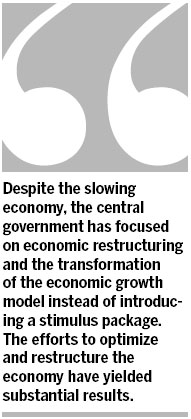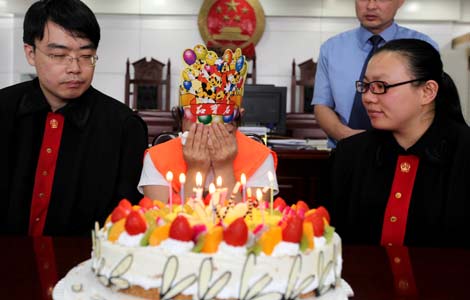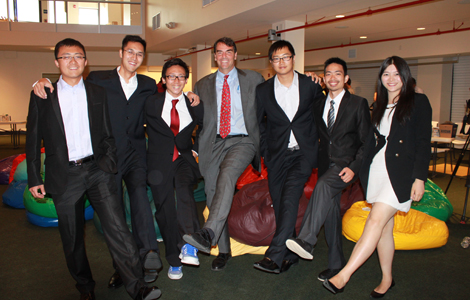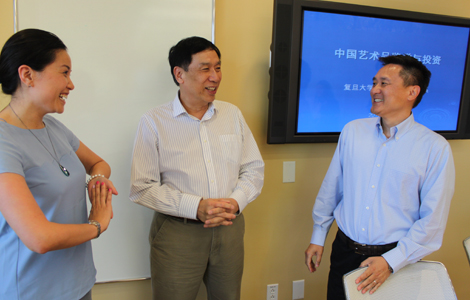A change for the better
Updated: 2013-08-05 07:03
By Qi Jingmei (China Daily)
|
||||||||

Despite the slowdown in economic growth, there are signs that economic restructuring is starting to yield results
Data shows that, against the backdrop of slowing economic growth, some changes quietly took place in the economic structure of China in the first half of this year. This was what the government's macroeconomic policies were intended to achieve and the changes were also consistent with the economic development strategy of the 12th Five-Year Plan (2011-2015).
Despite the slowing economy, the central government has focused on economic restructuring and the transformation of the economic growth model instead of introducing a stimulus package. The efforts to optimize and restructure the economy have yielded substantial results.
First, the tertiary industry grew at an accelerated speed and increased its contribution to the national economy.
China's GDP grew by 7.6 percent in real terms in the first half of the year, 0.2 percent lower than that of the corresponding period last year. There emerged an encouraging trend toward a better economic structure, with slower growth and a bigger contribution from the tertiary industry. China has been vigorously developing modern service industries such as the logistics industry and online shopping.
Second, the growth of the high-tech industry has accelerated.
In the first six months this year, the added value of high-tech industries went up by 11.6 percent, and high-tech industries and strategic emerging industries are displaying a good development momentum.
Third, the investment mix has improved and domestic consumption continues to grow.
Starting from the beginning of this year, thanks to the macro control policies, there was a smaller increase in investment month by month and an improved investment mix. In the first half of the year, the manufacturing sector saw an increase of only 15.6 percent in investment, while the investment in the tertiary sector increased by 33.5 percent and 23.5 percent in the primary sector. Retail sales of consumer goods grew at an accelerated pace month after month, rising faster in rural areas than in urban areas. And online shopping increased more rapidly than in-store purchases. Rural consumption, online shopping and other forms of consumption highlighted the upgrading of the consumption structure.
Fourth, prices were kept at a reasonable level and new jobs created.
Satisfactory results were achieved in stabilizing prices in the first half of the year with a 2.4 percent rise in the Consumer Price Index over the same period last year, far lower than the control target of 3.5 percent for the entire year. There were 7.25 million urban jobs added in the first half of this year, slightly higher than the number created in the same period a year ago and an additional 4.44 million rural jobs.
To achieve its strategic goal of keeping the current growth level and facilitating future development, the government will not deviate from the path of economic transformation and restructuring or introduce new regulatory policies to bail out or support the market. It will seek steady growth in the course of economic transformation and upgrading by improving the market economy and exploring a new type of urbanization.
The government will introduce a series of policies and measures to promote both the transformation of the development model and economic renewal. These policies and measures will be new driving force for economic growth in China.
First, by promoting a rapid growth in the consumption of information. In the remaining three years of the 12th Five-Year Plan period, the State Council has targeted an average growth in information consumption of more than 20 percent each year. According to a preliminary estimation, information consumption will reach 3.2 trillion yuan ($517.66 billion) by 2015 and the additional output value of the relevant industries will be more than 1.2 trillion yuan.
Second, by adding substance to the strategy of enterprises "going out" and the "bringing in" of foreign investment and expertise. In this regard, there are four main measures that can be adopted. First establishing the Shanghai Free Trade Pilot Zone in which to conduct a trial project for upgrading reform and enhancing opening-up. Second, restarting the negotiations on a China-US investment treaty, which would open China much wider to foreign investment, ending the past practice of excluding foreign investment from certain areas. Third, working out programs for a new round of urbanization and expanding the space for relevant industries to grow. Fourth, the government will not waver in its determination to reduce the real estate bubble.
It is expected that the economic growth rate in the third quarter will be the same as that of the second quarter, if not slightly higher, and the growth rate for this year will be 7.5 percent. However, the possibility of a downslide in the fourth quarter still exists. However, the government will adhere to the general trend of economic transformation and upgrading, and seek to take advantage of innovation-driven development and the dividends of further reforms.
The author is a researcher in the department of economic forecasting at the State Information Center of China. www.chinausfocus.com
(China Daily USA 08/05/2013 page11)

 British couple caring for special children
British couple caring for special children
 Fly for adventure at US air show
Fly for adventure at US air show
 Kobe Byrant meets fans in Shenzhen
Kobe Byrant meets fans in Shenzhen
 New Zealand milk stokes fears
New Zealand milk stokes fears
 Yemen enhances security over embassies
Yemen enhances security over embassies
 Chinese heavy ground combat vehicles join drill
Chinese heavy ground combat vehicles join drill
 Police find kidnapped baby alive in Henan
Police find kidnapped baby alive in Henan
 Privacy 'needed' for young offenders
Privacy 'needed' for young offenders
Most Viewed
Editor's Picks

|

|

|

|

|

|
Today's Top News
Pessimists ignoring China's strengths may lose out
Overseas investors welcome to bid in Beijing
US extends closure of embassies
New Zealand milk stokes fears
Riding the clean energy boom today
Magnetic attraction for EU SMEs
Mugabe wins Zimbabwe presidential election
EU solar deal hailed as blueprint
US Weekly

|

|





